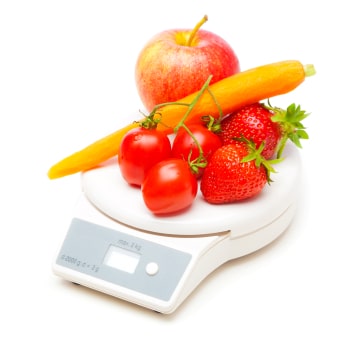 Are you able to recognize a healthy portion of food? Most people can’t. The fast-food industry with its emphasis on biggy sizes has “tricked” Americans into thinking a single serving is larger than it is – and that’s a problem. One of the reasons the obesity rate has risen in the last 50 years is because serving sizes have doubled and even tripled. We’ve come to expect a muffin to be the size of a baseball rather than the size of a lemon, which is comparable to a 2-ounce muffin. Many people fool themselves into thinking they’re eating a single serving when they bite into their breakfast mega-muffin.
Are you able to recognize a healthy portion of food? Most people can’t. The fast-food industry with its emphasis on biggy sizes has “tricked” Americans into thinking a single serving is larger than it is – and that’s a problem. One of the reasons the obesity rate has risen in the last 50 years is because serving sizes have doubled and even tripled. We’ve come to expect a muffin to be the size of a baseball rather than the size of a lemon, which is comparable to a 2-ounce muffin. Many people fool themselves into thinking they’re eating a single serving when they bite into their breakfast mega-muffin.
The labels on food packages don’t make things any easier. They often list the calories for a half serving rather than a full one, and not many people check to see how many servings are in a package. So they end up eating the whole package and take in twice the number of calories. No wonder waistlines are expanding!
To keep portion sizes under control, take a few minutes to eyeball and estimate a food’s portion size before you bite into it. Carefully read the fine print on food labels. Doing so can save you hundreds of calories a day. Here are some other guidelines for controlling portion sizes.
Get Skilled at Eyeballing Portion Sizes
A single serving of meat should be about the size of a deck of cards. A serving of veggies should be no larger than your closed fist. A cup of pasta would be about the size of a tennis ball, while a baked potato should be the equivalent sizewise of your computer mouse. Most people grossly overestimate how much is in a single portion. Learn to recognize how many servings you’re eating when you sit down to a meal at a restaurant. If they give you a mega-portion, simply package some into a to-go box before starting your meal. Out of sight is out of mind, and it won’t end up your fork.
Change Your Plates and Utensils
Plates have grown larger in size too. It’s not uncommon to see food served on 12-inch plates these days, and large plates encourage overeating. Take control of the situation by replacing larger plates in your kitchen with 9-inch ones. When you fill up a 9-inch plate, you’ll trick your brain into believing you’re eating more because the plate is full.
Choose a plate in a dark blue or green color, and avoid brightly colored plates in red and yellow. Bright colors stimulate appetite and cause you to eat more. To curb your appetite, even more, switch your fork and knife for a pair of chopsticks. You won’t be able to eat as fast, and your appetite hormones will have the opportunity to kick in while you’re still eating.
Eat High-Volume Foods
Fill up the majority of your plate with vegetables and lean protein. Allocate a smaller portion of your plate for starchy foods. Vegetables have a high water content that will fill you up faster. Plus, you’ll get more food for fewer calories. Just don’t douse your veggies in a rich sauce.
Add Some Spice to Your Portions
Bland food won’t satisfy you as readily as food that’s strongly flavored. Try adding herbs, spices or hot sauce to your food. You’ll fill up more quickly, and you’ll be content with smaller portions.
The Bottom Line?
Don’t let your portion sizes mushroom out of control or you could end up consuming two or three times the calories you planned. Be aware of how much you’re eating each and every time you sit down to a meal.
Related Articles By Cathe:
5 Times You Eat More Than You Think You Do
Weight Loss: Controlling Your Portion Sizes
Are You Counting Calories Correctly?
Portion-Control Plates Can Help You Lose Weight
Portion Size Trumps Mindful Eating for Controlling How Many Calories You Eat

